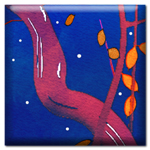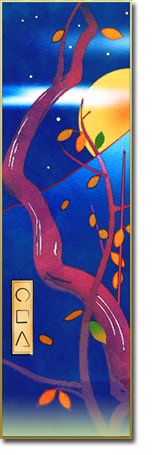On The Way: The Daily Zen Journal
Source-Ancestral Discourse
Hsieh Ling-yun (385-433)

I often wander these coastal mountains with friends, monks, and masters of the Way. Karmic transformations brought us together here, mind and spirit, searching for the insight beyond words that understands the Way. Sick in bed, no official work, I’ve got time on my hands—so I’ll try to recreate the evolution of our ch’i-weave thought, and perhaps settle the search for source-ancestral awakening.
According to Buddha’s teaching, the Way of a sage may be remote, but through earnest study it can be realized—for he taught that ending the tangles of thought and bringing the mirror to life, you come to a gradual awakening.
According to Confucius’s teaching, the Way of a sage is so mysterious even Sunset-Peak Return never quite mastered it—for he taught that only by becoming Absence and mirroring the whole can you return to the final-and-total enlightenment of inner-pattern’s primal-unit
But there is a master of the Way with a new doctrine that says the tranquil mirror is all mystery and shadowed-emergence, and without partial stages or degrees. There are no limits to where earnest study can lead, so where could it complete itself?
Here today, I reject Buddha’s gradual awakening, and choose instead realization itself. And I reject Confucius’s never-quite-mastered, and choose instead the final-and-total enlightenment of primal-unity.

The final-and-total enlightenment of primal-unity is altogether different than gradual awakening, and realization is not at all never-quite-mastered. An understanding of inner-pattern rejects both and yet chooses each.
In this, it’s far from either Buddha or Confucius. I think the two of them only taught as they did because they were trying to rescue sentient beings. But the teachings of this Taoist master explain insight ch’i-deep.
My friends and I ventured to analyze this new doctrine and explain just what it is. We humbly tried to unravel the implications of ch’i-deep, and slowly discover what awakening might be.
Dharma-Entire asked: “In this doctrine of reverent mirror-clarity, primal-unity awakening, instantaneous and whole comes when you fathom with illuminated insight the source-ancestral, final-and-total just there where things emerge. However delighted I am with this new discovery, there are still things I wonder about.
“To fathom with illuminated insight and all the way through, you must become inner-pattern and cut off desires that want things different. We long and long because we’re tangled in confusion and doubt. But once you see the source-tissue inner-pattern, you’ve cut off those desires. We’re only tangled in confusion and doubt because we’ve turned away from the source-ancestral.
“But how can we talk about this? Don’t the sutras say that if you chase after new studies you’re far from prajna-awakening, illuminated insight lost completely? Absence itself teaches us how to embrace inner-pattern.

So it’s all perfectly evident here before us—but we’re restless and unsure, and once you set out on some gradual search for the great source-ancestral, there’s nothing to rely on. If you’re still tangled in the tawdry dust of this world, you can struggle for countless kalpas and only end up further away; further away and full of sad longing for the contentment of embracing inner-pattern itself.
“I bow and await the sage river of your thought.”
I answered: “The Way and our everyday lives: without inner-pattern, they seem unrelated. And that’s how it is when teachings use words and concepts. Words and concepts only teach the illusions names conjure, but without words and concepts there’s no illusion. Wisdom is made of wild thusness, all clarity-absolute itself, but there’s nothing of that in expedient teaching meant to nurture sentient beings.
“No-clarity can’t diminish clarity, of course, and the source-tissue root is there in expedient teachings. But no-illusion never follows from illusion, and nurturing sentient beings precludes knowing the source-tissue root.
“You can chase words and concepts for endless kalpas, and never become emptiness itself; but with diligent attention, you can know the shimmer of this existence-tissue world brilliant as sunlight.”
Dharma-Entire asked again: “Doesn’t it follow, then, that the Ways of Confucius and Buddha are the same, that because they both use the illusions names conjure to rescue sentient beings, there’s no real difference between them?
“But in the spirit-Way realm, Sunset-Peak Return alone didn’t need instruction from Confucius. And in the appearance-and-reality mystery, simple minded people all needed instruction from Buddha. Those two sage-masters established profound teachings in words, and how could we ever turn away from them?”

I answered again: “Those two teachings aren’t the same. Principles and practices adapted to the individual needs of sentient beings are different in different places. In broad comparison: those differences depend on the people. We Chinese easily see the inner-pattern directly, but find it difficult to pursue teachings. So we close off the tangles of learning and open up final-and-total primal-unity.
“Indians, on the other hand, easily pursue teachings, but find it difficult to see inner-pattern directly. In this, they close off sudden awakening and open up gradual awakening. In gradual awakening, you live blind to the substances of sudden awakening.
“But in the final-and-total enlightenment of primal-unity, you cut off the very thirst behind tangles of learning. That’s exactly how we Chinese achieve inner-pattern awakening—not through the misguided Way of gradual practice, and not through learning. But Indians imagine inner-pattern awakening comes through learning and the misguided Way of gradual practice.
“So even if sudden and gradual seem the same in substance, teachings using words and concepts are in practice always different. The old masters considered primal-unity itself to be the Way of learning, so how could the teachings of Confucius and Lao Tzu not be the same? Both probe the source-ancestral, and more: the very substance of things, that wild thusness all clarity-absolute itself!”
Dharma-Entire asked a third time: “How deeply your answers search! Whether Chinese or Indian, people by nature find insight both difficult and easy. That’s why the teachings of Confucius and Buddha are both alike and different. We admire keeping deep principles and practices close to the commonplace, but the superior practice is to make the dark final-and-total abyss into a bright and clear mirror.

“Simple-minded people following along dull and blind—that’s inferior. It leads to the precept of teaching according to people’s needs, and the faith that people just following along will certainly realize the source-ancestral.
“Confucius abandoned the road of sage learning; Buddha opened the path of gradual awakening. But the traps and snares of words trying to capture insight: they’re all confusion and error. So how can the people return to wild thusness all clarity-absolute itself?
I answered a third time: “Winter and summer are different in nature, but they share spring and autumn in their beginnings and endings. Day and night are different in reality, but they share dusk and dawn in their departures and returns. It’s like that for the essential inner-pattern, too—but how can coarse people come to realize it?
“Those who don’t trust gradual awakening nurture silence to fashion sudden liberation. Those who trust reverent teachings obscure themselves to become masters of learning. Masters of learning never leave the six classics, as if classics could lead to sudden liberation. And they don’t see Tripitaka scriptures are just traps and snares one after another. Who can doubt it’s all confusion and error? Only after you’ve to fish and rabbit, only then can you nurture the people.”
Hsieh Ling-yun (385-433)
Excerpted from The Way of Chan-Essential Texts of the Original Tradition David Hinton 2023





It is quite a treasure to find a new piece in translation and one full of terms that seems to predate the usual ones we find in Buddhism and Zen. In bringing Buddhism to new lands, it only seems natural that the earlier understanding of the Way, Taoism in this case in China, would find a way to make sense of the new teachings as similar to their native teachings of the Way.
By softening our minds we can easily access what seems to be quite new terms, which represent how these new teachings in Buddhism became part of the native thought. We know Hsieh Ling-yun as a very famous poet of China who is credited with starting the tradition of “rivers-and-mountains” poetry. We can find translations of his poetry, but this is the first essay we find in translation.
What we see here is friends trying to understand this new teaching Hsieh Ling-yun first learned from Way Born or Tao Sheng. This appears to be an early introduction of Chan in China.
Unlike those of us brought up in the Western traditions, the leap into Chan for ancient Chinese seems more straightforward. Think of the changes you felt when you first were introduced to Zen and meditation, and in the early days how very few people there were to help you make sense of these “new” teachings.
Concluding now, here is the beginning of one of the well known poems of Hsieh Ling-yun:
Plans beginning to form, I set out,
walking-stick in hand, hiking alone
through gorges and across streams,
into mountains and over ridgelines,
crossing summits without resting,
tracing creeks back without pause.
Combed by wind and rinsed by rain,
or stepping into dew among stars,
I sifted through our shallow thoughts
and left their tight compass behind.
Returning to the vastness with you,
Elana, Scribe for Daily Zen